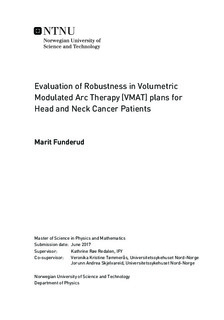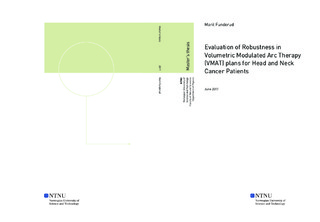| dc.description.abstract | Purpose: To investigate the robustness of volumetric modulated arc therapy (VMAT) plans for head and neck (H&N) cancer patients.
Methods and materials: The patient population consisted of 15 patients with H&N cancer having received VMAT radiotherapy at the University Hospital of North Norway (UNN). Original treatment plans were compared to alternative plans where a virtual bolus was applied during optimization. Perturbed uncertainty plans were generated for various isocenter shifts in three directions, and the widths of the uncertainty plots were calculated. In addition, the original plan was compared to three other plans where different optimization strategies were used; the simultaneous, sequential and intermediate plan. Comparison was done in terms of various dose-volume parameters, the conformity index (CI), homogeneity index (HI) and newly proposed robustness index (RI). Verification of all plans was performed using a Delta4 phantom. The global gamma index was found, where a pass-fail criteria of 2% dose difference (DD) and 2 mm distance to agreement (DTA) was used. The difference between including, or not including, the fixation mask in the body contour for dose calculation was determined. Wilcoxon signed rank test was applied to determine whether there was a statistically significant difference in the mentioned parameters.
Results: Comparing the original plan with the plan optimized with bolus, the dose to 98% (D98) of the planning target volume (PTV) to which 52 Gy had been prescribed, PTV52, was significantly higher in the original plan. That was the case for the maximum dose (Dmax) to the spinal cord as well. D98 of PTV64 and the mean dose (Dmean) of both parotid glands and both submandibular glands were significantly higher in the plan which was optimized with bolus. The gamma index and RI were determined to be significantly superior in the plan which was optimized with bolus. The widths of the uncertainty plots were determined to be significantly narrower in the original plan for Dmax of spinal cord and spinal cord planning organ at risk (PRV). The simultaneous plan performed the best in terms of dose coverage to target volumes, as D98 of ITV52, ITV64, PTV52, PTV64 and PTV68/70 all were significantly higher than in the original plan. The HI was determined to be significantly superior in the simultaneous plan for PTV52, PTV64 and PTV68/70. The intermediate plan, followed by the sequential plan, was determined to have significantly better $\gamma$ indices than the original plan, in addition to having the best the robustness indices. Small, but significant differences were found between including, or not including the fixation mask in dose calculation.
Conclusion: The results in the comparison between the original plan and the plan which was optimized with bolus were ambiguous and none of the plans were proven to be superior to the other. The intermediate plan, followed by the sequential plan, had the best gamma and robustness indices, suggesting they can be further investigated as a method to improve practice. Also, the simultaneous plan was better than the original plan, implying that taking the time to optimize and calculate dose several times after a plan has met the tolerance criteria, is worth the while. It was concluded that the fixation mask should always be included in the body contour for dose calculation. | |

